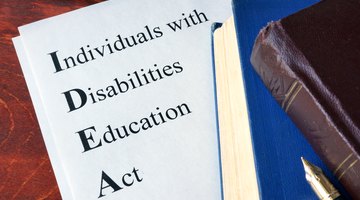IDEA vs IDEIA: Similarities and Differences
The history of the special education timeline spans the length of public education in the United States. However, treatment of students with disabilities has not always been as equitable as it is now. Even with the great leaps the U.S. has made over the years in equitable education standards for students with disabilities, there is still a long way to go before students with disabilities can truly experience an equal opportunity for education in many places in America. FAPE is also involved in the IDEA and IDEIA acts. These acts and programs allow for educational agency for those students with disability needs for appropriate education for their needs in their school year. These acts allow students to have the least restrictive environment available for their needs allowed from the U.S. Department of Education.
These acts are also similar to those enactments with the ADA (the Americans with Disabilities Act). These acts also look to specific learning disabilities and conditions (like autism, traumatic brain injury, deaf-blindness, or emotional disturbance) to help with the student’s visual impairment, orthopedic impairment, hearing impairment, language impairment, or health impairment. These acts do affect school-aged children, and local education agencies and schools can use their acts (with parental consent or consent of the child’s IEP team for these students) to allow for early intervention and accommodations in public and private school systems. The Rehabilitation Act of 1973 is also similar to these acts in what they do for the disabled community in the U.S.
These programs do use federal funds to function in schools, and these acts do have procedural safeguards for use. Most schools have an office of special education that help in the school and life activities of their special education students. These acts allow for some individualized education programs in schools, including high schools. While federal law does protect students and individuals with disabilities through these acts, as well as offering the Child’s IEP program as well.
What Is IDEA?
The Individuals with Disabilities Education Act, or IDEA, is a piece of legislation that regulated the accessibility of public education for students with disabilities between 1990 and 2004. Its goal was to make public education more equitable so that students with disabilities had the same opportunities as students without disabilities.
What Is IDEIA?
In 2004, Congress reauthorized IDEA but with some important changes. The reauthorized legislation was significantly different enough from the original law that Congress decided to rename it the Individuals with Disabilities Education Improvement Act of 2004, or IDEIA.
Why the Individuals With Disabilities Education Improvement Act of 2004 was Passed
One of the reasons Congress amended IDEA was because its language influenced teachers to misidentify African-American students as having learning disabilities. This misidentification led to higher dropout rates in African-American student populations.
Another reason Congress chose to amend IDEA in 2004 was to align the law with the No Child Left Behind Act of 2001. The purpose of the No Child Left Behind Act was “to ensure that all children have a fair, equal, and significant opportunity to obtain a high-quality education and reach, at a minimum, proficiency on challenging State academic achievement standards and state academic assessments.”
The new changes to IDEA required states to establish performance goals for students with disabilities that aligned with the goals of their peers without disabilities. The updated law also required schools to report the progress of students with disabilities on standardized testing, and the law incorporated provisions for improving graduation rates and dropout rates.
Additionally, the No Child Left Behind Act stipulated class-size caps and required that teachers achieve “highly qualified status,” especially in regard to working with special education students.
The Origin of Public Schools
In colonial America and the early days of the nation, children were not required to go to school. In fact, there was once a time when schooling cost money, and only families with the means to afford it could choose to send their children to school. There was no special education at this time, and families with children who had special needs often had to educate them at home.
For Puritans in the 1600s, the church managed education for the community. Children learned to read and write using the Bible and catechism books. Wealthy community members often donated funds for churches to buy the necessary materials to run these early schools. Puritans put a high value on conformity, so attempts at special education were likely minimal. The Puritan schools of New England later developed into “common schools,” where any child from the region or town could attend to learn basic grammar school principles.
Immigration and the Common School
In the 19th and 20th centuries, more people from Europe began immigrating to the United States. Many of those already living in the U.S. displayed intolerance toward these newcomers because they did not speak English or weren’t Protestants. However, social reformers believed that schooling all children together regardless of their heritage, religion or language would foster a new sense of togetherness for the nation. It was also the first step toward special education.
One such reformer was Horace Mann. First a lawyer, Mann later became a Massachusetts state senator and then the first leader of the Massachusetts State Board of Education. During his tenure, Mann endeavored to form a standard curriculum for schools in the state of Massachusetts. He also sought to standardize teacher training, believing that teachers were the key to uniform quality education throughout the state. To that end, he helped establish the first normal school in 1839.
Likewise, Mann was a proponent of common schools. He advised towns to create their own tax-funded common schools, not only for the betterment of individuals and the town but also to create an atmosphere of tolerance and respect in the increasingly diverse nation. At common schools, children learned reading and writing, history, math and geography. Common schools emphasized self-discipline and morality as well by emphasizing biblical lessons in the curriculum.
Reformers believed that common schools would increase the overall social welfare of their towns by helping students develop the social skills they would need to contribute to society. However, children from poor families often attended school less frequently than their more affluent classmates. Poor children were also more likely to quit school entirely.
To solve the problem of low attendance by the students who reformers believed needed school the most, public schools lobbied their state and local lawmakers, who then created the nation’s first compulsory school attendance laws. Under these new laws, parents who did not make their children go to school could find themselves answering to the police.
The History of Special Education Timeline
Over the years, students with disabilities and their parents have fought many historic battles for equity in education. The history of the special education timeline begins as early as the 19th century, when social reformers implemented compulsory school attendance laws with the hopes that school for everyone would benefit the common good.
The first special education programs were introduced to urban schools in the late 1800s. These programs were targeted at children considered “at risk” because they lived in the poorest areas of the cities. In addition to their general education courses, these children received training in manual skills such as sewing, cooking and carpentry. These programs have been criticized, however, because they targeted African-American children for “moral training.”
In the same time period, school districts began to offer separate schools and classes for children with intellectual disabilities or sensory disabilities. Many well-known schools for the deaf and blind were opened at this time. Nonetheless, classes designed to help students with learning disabilities or intellectual disabilities did not become common until the 1940s. Most programs designed for students with special needs were private or required students to live in designated facilities. For families of average monetary means, these programs were not accessible.
Brown v. Board of Education
In 1954, the U.S. Supreme Court struck down segregation as the law of the land in the case Brown v. Board of Education. The court found that segregated schools deprive African-American students of equal educational opportunities.
Not only was this a landmark case for civil rights, it also encouraged parents of children with disabilities to file suit against school districts that excluded or segregated their children. These parents’ renewed outrage created the forward motion needed to begin addressing equitable education for students with disabilities.
Elementary and Secondary Education Act of 1965
In 1965, Congress signed the Elementary and Secondary Education Act, or ESEA. ESEA was designed to delegate resources to increase impoverished students’ access to education. In 1966, Congress amended ESEA to include a provision addressing the rights of handicapped children. The new provision funded new and existing programs for students with disabilities in public schools.
Four years later, in 1970, Congress replaced ESEA with the Education of the Handicapped Act. The Education of the Handicapped Act provided funding to states for the purpose of developing educational programs and resources for students with disabilities. Many advocacy groups complained that the law was useless, however, because it did not include requirements on how to use the allocated funds.
The Education for All Handicapped Children Act of 1975
On the heels of two significant court cases regarding the treatment of children with disabilities in public schools – Pennsylvania Assn. for Retarded Children v. the Commonwealth of Pennsylvania (PARC) and Mills v. Board of Education of District of Columbia – Congress signed Public Law 94-142, also known as The Education for All Handicapped Children Act of 1975. Through this act, Congress wanted to make it clear that all students with disabilities have the right to receive an education and that if the state fails to give them adequate, equitable opportunity for an education, it should be held accountable.
The law initially focused on issues of access. Congress wanted to make sure that special education services were available to the students who needed them. Additionally, the law included safeguards to protect the rights of students with disabilities and their parents.
Comparing IDEA and IDEIA
In 1997, Congress amended the Education for All Handicapped Children Act of 1975 by replacing it with the Individuals with Disabilities Education Act. IDEA was reauthorized in 2004 with changes, creating the Individuals with Disabilities Education Improvement Act of 2004. The purpose of IDEIA is to ensure that all special needs children are provided with an equitable chance at an education equal to their peers without disabilities. Although IDEA had the same purpose, there are key differences between the acts.
The majority of the differences between the two acts comes down to the details of their language. The purpose of IDEA, according to the law’s language, is as follows: “to ensure that all children with disabilities have available to them a free appropriate public education that emphasizes special education and related services designed to meet their unique needs and prepare them for employment and independent living.” The amended version includes the addition of preparation for further education for students with special needs.
Throughout the text, IDEIA amends the word “student” to "child," signifying a cutoff age for the law’s protections. This is restated explicitly in the addendum to the section on eligibility. Additionally, under IDEIA, a student’s individual education plan, or IEP, must be re-evaluated every year. The IEP must include “appropriate measurable postsecondary goals based upon age-appropriate transition assessments related to training, education, employment, and, where appropriate, independent living skills; (bb) the transition services (including courses of study) needed to assist the child in reaching those goals.”
The updated law also clarifies the meaning and purpose of IEPs: “a statement of measurable annual goals, including academic and functional goals, academic and functional goals, designed to – (aa) meet the child’s needs that result from the child’s disability to enable the child to be involved in and make progress in the general education curriculum; and (bb) meet each of the child’s other educational needs that result from the child’s disability.”
The Every Student Succeeds Act
In 2015, Congress passed the Every Student Succeeds Act, or ESSA. ESSA replaced the No Child Left Behind Act, but it did not do away with the NCLB’s mandates for standardized testing. Under ESSA, some students with disabilities are exempt from taking standardized tests with their peers. This exemption is reserved for students with severe cognitive disabilities who have to take an alternative assessment instead.
Related Articles
References
Writer Bio
Rebecca Renner is a teacher and college professor from Florida. She loves teaching about literature, and she writes about books for Book Riot, Real Simple, Electric Literature and more.










